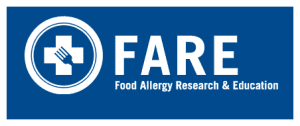Nutrition for Healthy Teeth and Gums
A healthy diet will help your bones and muscles to grow strong and for all of your body’s systems to work together, so you can stay healthy. Plus, a healthy diet is necessary to keep your mouth, gums and teeth in good shape, too. Whatever you eat first passes through your mouth, and usually requires some chewing with your teeth and gums. If you choose to eat unhealthy foods regularly, it will be very difficult to maintain a healthy smile, even with good dental practices like brushing and flossing. Learn about the best foods for your dental health to keep all your pearly whites looking and feeling good.
More information about nutrition, snacking advice, and secret sources of sugar at The Dental Center.
Food Allergies
Food allergies are present among many of our school age children. Please visit the websites listed for additional information.
Food Allergy Resource and Education Network
 Food Allergy Research & Education (FARE) works on behalf of the 15 million Americans with food allergies, including all those at risk for life-threatening anaphylaxis. This potentially deadly disease affects 1 in 13 children in the United States – or roughly two in every classroom. FARE is a 501(c)(3) nonprofit organization that was formed in 2012 as the result of a merger between the Food Allergy & Anaphylaxis Network and the Food Allergy Initiative.
Food Allergy Research & Education (FARE) works on behalf of the 15 million Americans with food allergies, including all those at risk for life-threatening anaphylaxis. This potentially deadly disease affects 1 in 13 children in the United States – or roughly two in every classroom. FARE is a 501(c)(3) nonprofit organization that was formed in 2012 as the result of a merger between the Food Allergy & Anaphylaxis Network and the Food Allergy Initiative.
Weight Control
Below are some sample programs that support healthy weight goals.
“Footloose Fridays”
In order to encourage healthy lifestyles that include exercise, consider launching a new walking program. Every Friday, students and teachers can take healthy walks to various destinations in the community or explore walking paths within the school. Students will set goals, track their progress and celebrate achievements. Please offer encouragement to your students/child as we walk our way to health! Click here for walking project ideas.
“Kids Can Cook”
To introduce school age kids to healthy cooking, plan an afternoon of cooking and sampling. Create menus that include whole wheat, fruits, vegetables, olive oil and healthy products. Have the students create various courses in a meal or take one item such as apples and prepare them in a variety of different ways. Be creative and have fun.
“Nutrition Facts for Kids”
The keys to achieving wellness through nutrition include communication, guidance and support. Communicate with kids about dietary expectations by providing them with the right nutritional choices. Allow them to become active participants in choosing the right foods by going grocery shopping and preparing healthy recipes together. Guide and support them by teaching them about the various food groups, the food pyramid, how to read food labels and the role food plays in their health and overall wellness. Kids who understand the difference between nutritious and unhealthy foods become motivated to make wise choices that follows them into adulthood and creates a lifetime of lasting wellness. Find lots of nutrition activities for kids and teachers at BigOven.com
“Healthy Breakfast with Santa”
 Instead of having the same old breakfast with a sugary donut or high calorie breakfast sandwich, cook up some pancakes and use light syrup, light butter and serve turkey sausage and bacon and accompany it with some fresh fruit and a spoonful of fat free topping. Treat bags can be filled with healthy nutritional activity books and new crayons to use the first of the year. Have the students up and moving while jingling those sleigh bells to bring Santa in while singing “Here Comes Santa Claus”. This will surely help them burn a few extra calories before sitting on Santa’s lap.
Instead of having the same old breakfast with a sugary donut or high calorie breakfast sandwich, cook up some pancakes and use light syrup, light butter and serve turkey sausage and bacon and accompany it with some fresh fruit and a spoonful of fat free topping. Treat bags can be filled with healthy nutritional activity books and new crayons to use the first of the year. Have the students up and moving while jingling those sleigh bells to bring Santa in while singing “Here Comes Santa Claus”. This will surely help them burn a few extra calories before sitting on Santa’s lap.
“Two Bite Club”
The Two Bite Club Booklet from the USDA
This educational storybook, available in English and in Spanish, was developed to introduce MyPlate to young children. Parents or caregivers read the book to children and encourage them to try foods from each food group by eating just two bites, just like the characters in the story. The back of the book contains a MyPlate coloring page, a blank certificate for the Two Bite Club, fun activity pages for kids, and Tips for Growing Healthy Eaters.
Various Websites with Nutrition Resources
- A Children’s Guide to Eating Healthy Eating is the most important thing you do each day. Food fuels your body and keeps you energized. It helps you grow, think, and play.
- Jam School Program brings physical activity and health education into the classroom. JAM is designed to teach kids (and adults) healthier lifestyle habits. JAM is a free wellness resource for schools.
- Health and Physical Fitness Resources for Kids (This resource site was kindly shared with the School Based Health Team by Kerri – a 6th grader doing research)
- Active Academics has been developed to provide practical ideas to classroom teachers for integrating physical activity throughout the school day.
- Cardiac Kids Program offers screening and education for heart health
including nutrition and exercise. - Nourish Interactive is your free one stop resource for fun nutrition games for kids, interactive nutrition tools and tips for parents and health educators to use to promote healthy living for the whole family. Created by nutrition and health care professionals, Nourish Interactive’s nutrition education website gives children and families the knowledge and skills they need to make healthy choices.
- Nutrition Websites for kids and teens. Highly interactive, multi-level web site with educational tools for kids and parents on topics ranging from indoor to outdoor.
- Take Charge Be Healthy is a web-based health module targeting middle and high school-aged youth (ages 12-18). The module focuses on physical activity, nutrition, and other health topics.
- Fuel Up to Play 60 is a program founded by the National Dairy Council and NFL, in collaboration with USDA, that empowers students to take charge in making small, everyday changes at school.
- NFL Play 60 NFL athletes grew up playing in communities all across America. Now, through NFL PLAY 60, they’re encouraging kids in neighborhoods everywhere to come out to play for 60 minutes a day.
- Alliance for a Healthier Generation has taken the latest research on childhood health and combined it with the most effective school policies to maximize impact. They divided their approach into wellness modules to create a workable framework that sets specific actions to help make your unique school healthier.

